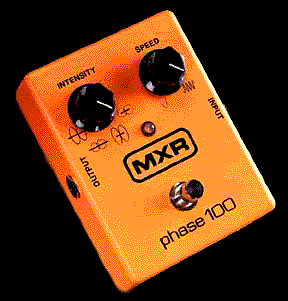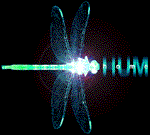
The MXR M107 Phase 100 modulation effect pedal, clearly audible just before the opening verse of "I'd Like Your Hair Long".
Acting something like a big brother to the Phase 90 pedal, and while not quite identical, the phase sounds of the latter can be found somewhere within the middle two phase width / notch depth / regeneration settings of the Phase 100's 4-way "Intensity" knob.
The Phase 100 is a ten stage phaser, in contrast with the Phase 90's four phasing stages, or all-pass filters, and the Phase 45's two phasing stages. However, only six of these stages modulate the input signal by 'sweeping' up and down (or rather, across) the frequency range via the internal LFO, the rate of which is controlled by the "Speed" knob, with the other four stages being fixed, or unmoving, for a richer, more substantive output tonal character.
The four glyphs of the "Intensity" switch settings represent the four possible combinations of two internal switch states:
1 The phaser's LFO amplitude, or width - how much, or how 'widely' it will sweep across the frequency range - represented by the horizontal double arrows as wide or narrow.
🠬🢜🢜🢜🢜🢜🠮
🠬🠮
2 The notch depths & regeneration amounts of the various phase stage combinations - represented by the large ellipses and small circles as deep or shallow from the perspective of notch depth, and from the perspective of regeneration as + more or − less.
⬯⬯
⭘⭘
Regeneration, sometimes referred to / labeled as 'feedback' or 'resonance' on other devices, is how much of the wet, affected signal is 'fed back' into itself (or other parts of the circuit) for an additive, cumulatively enhancing effect on the notches created by summing pairs of phase stages together. With the Phase 100, 6 modulating phase stages combine to make 3 sweeping notches, and 4 fixed phase stages combine to make 2 stationary notches.
Additionally, it's possible that the two switch state combinations represented by the smaller circles (shallow / − less) are using negative (subtractive) regeneration, as the glyph imagery there slightly overlaps upon itself, like in a Venn diagram.

